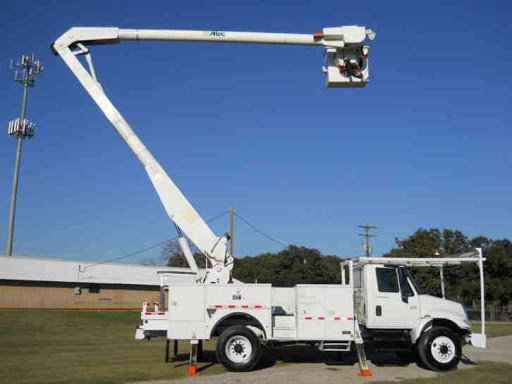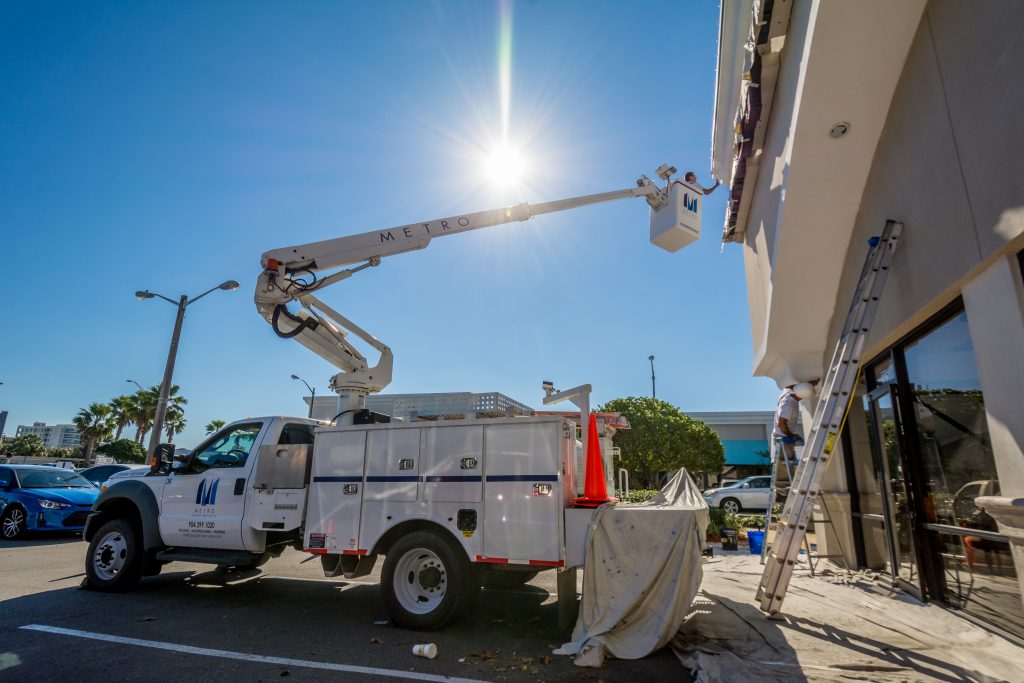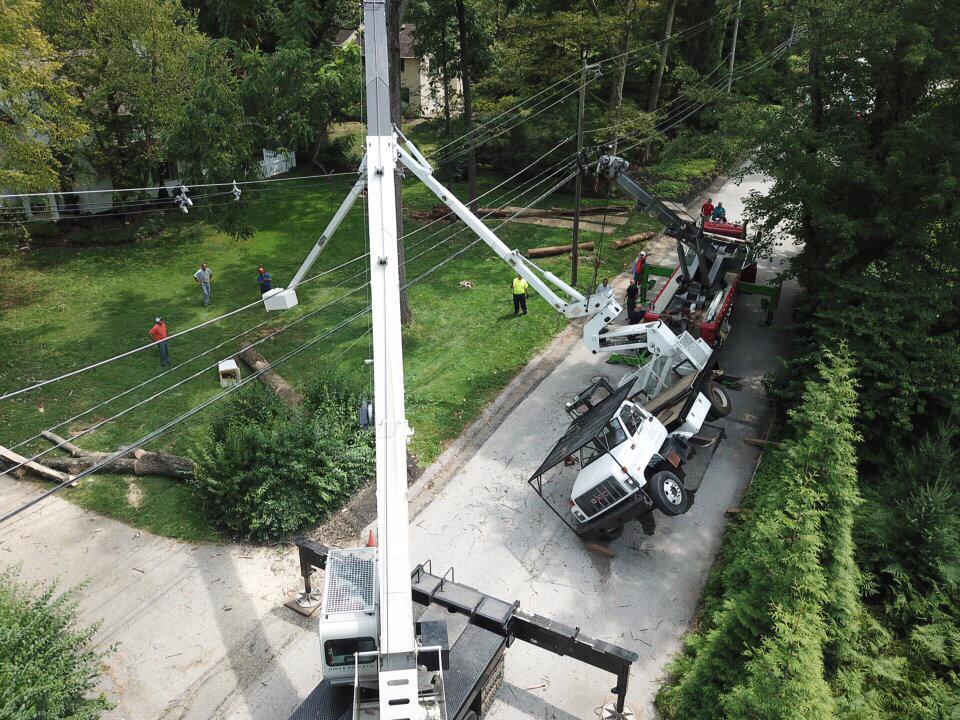
Modern life brought us various services as gifts that make our daily routine much simpler and more comfortable, such as Electric power, fiber optic services, telephony, and others.
These services reach all users, mainly through overhead cabling. These systems require the use of bucket trucks, both for their installation and for maintenance and repairs.
But there are some risks with bucket truck use that can be prevented through simple safety inspections, which is why regular bucket truck inspection is so important.
What is a bucket truck?
When we talk about bucket trucks, we refer to those vehicles capable of lifting a worker along with their tools to access a project that is executed in the heights.
Thanks to its hydraulic platform, people can carry out risky jobs such as maintenance of high voltage cables, more efficiently because they have controls that the vehicle operator operates to control the movements of the bucket truck and have more effective results.
Bucket trucks have different types of lifting actions. Some use a kind of scissor that goes up and down on a hinge. Other types of actions include raising a telescopic and articulated platform; This technique is called “the elbow.” The boom moves up and out on a hill, something as the name implies.
These trucks allow most of the modern conveniences that need to be installed to be done more conveniently and easily. Services such as telephony, electricity, cable, and the Internet are top-rated and are available because bucket trucks have made the installation process and carrying out these projects more accessible.
Can you imagine climbing a 65-foot ladder in the air? It would be quite complicated and riskier, which is why we have the bucket trucks to take us safely to a relatively high construction site.
Bucket trucks are a crucial tool in power line work, cable/internet, forestry, sign, light repair/installation, window washing, painting, and even Christmas decorations.

Bucket Truck Features
There are different platform bucket trucks, which fulfill different functions. These are one of the essential characteristics of each of these tools:
Articulated or telescopic truck lifts
- This type of platform is used for outdoor work located at high altitudes, such as repairs, maintenance, power lines, etc.
- It consists of an articulated arm capable of rising to heights of up to 62 m. and rotate 360 .
- The platform can be used by a maximum of three people depending on the case.
Self-propelled scissor lifts
- This type of platform is used for electrical installation work, maintenance, industrial assemblies, etc.
- The platform is a vertical elevation with the highest reaches of 25 m. With a large capacity of people and auxiliary work teams.
- They can be powered by batteries, the internal combustion engine, and four-wheel drive.
Articulated or telescopic self-propelled platforms
- They are used for work in hard-to-reach areas. They can be of an articulated arm and telescopic section or only telescopic with a reach of up to 40 m.
- They can be powered by batteries, with a diesel engine and all-wheel drive or a combination of both systems.
Risk factors of a bucket truck
All jobs carry associated risks that can endanger the physical integrity of employees. In the case of activities related to the use of bucket trucks, the risks can be even higher than in other jobs; some of the main dangers that employees face are the following:
Falls at a different level
They can be due to:
- Tipping of the equipment as a whole when it is located on a sloping surface or in poor condition, lack of stabilizers, etc.
- Absence of safety rails in part or all of the perimeter of the platform.
- Carry out work using auxiliary elements such as stairs, stools, etc. to gain height.
- Work on the platform without properly anchored personal protective equipment.
- Breakage of the work platform due to overload, deterioration or misuse of it.
Fall of materials on people or goods
They may be due to:
- Team overturn.
- Unprotected work platform.
- Breakage of a work platform.
- Loose tools or materials left on the surface.
- People are located in the vicinity of the work area or under the vertical of the platform.
Team rollover
It can originate from:
- Work with the chassis on an inclined surface
- Sinking or softening of all or part of the support surface of the chassis
- Do not use stabilizers, do it incorrectly, support them totally, or partially on poorly resistant surfaces.
- Overloading of the work platforms with respect to their maximum permitted resistance.
Falls to the same level
They usually have their origin in the lack of order and cleanliness on the surface of the work platform.
Entrapment between any of the moving parts of the structure and between it and the chassis
They are produced by:
- Carry out some type of action on the structure during the lowering operation.
- Stand between the chassis and the platform during the lowering of the work platform.
Blows, shocks, or trapping of the operator or the platform itself against fixed or moving objects
They usually are produced by lifting movements or small movements of the equipment in the vicinity of fixed-mobile obstacles without the corresponding precautions.
Many of these bucket truck hazards can be easily prevented by performing a regular bucket truck inspection. Taking time to do this could help to significantly reduce not only accidents but also material and human losses.

Safety Tips for Using the Bucket Truck
To avoid bucket truck accidents, several safety rules must be implemented, not only before starting but before the platform is initiated and raised, to perform the movement of the bucket truck once the platform has already been raised and after that has already been used.
What to do before launching the platform?
A full bucket truck inspection should first be done to detect any defects or failures that may affect the safety of workers. The examination should consist of the following:
- Inspect for deteriorated welds or other structural defects.
- Check for leaks in hydraulic circuits, damage to various cables, the state of the electrical connections, tires, batteries, and brakes.
- Make sure that the operating controls work correctly.
Each of the defects must be evaluated by qualified personnel, who may determine these constitute a risk to the safety of the equipment. Each of the irregularities found that may be a risk must be corrected before using the equipment.
What to do before raising the platform?
- It is necessary to verify if there are electrical lines of A.T. in the vertical of the team. If so, you have to have a prudent safety distance. If possible, the right solution would be to isolate them or cut the current while the work is finished.
- Check carefully both the state of the support surface that the equipment has, as well as its level.
- Make sure that there is no greater weight on the platform than established.
- It must be verified that, in the case of using stabilizers, they have been deployed correctly according to the standards dictated by the manufacturer. Furthermore, it must be ensured that, as long as the platform is not in the transport position, they cannot be acted upon.
- Verify that the access door is without problems and that the state of the protections is correct.
- It is essential to verify that the seat belts are properly anchored for bucket truck safety.
- Before starting to carry out the work, the area in which it is going to work must be delimited, in this way it prevents pedestrians from circulating near the area.
What to do when starting the raised platform bucket truck?
- It is necessary to check that there are no obstacles in the direction where there is going to be movement. In addition, it is required to make sure that there is no unevenness in the support surface; it must be substantial.
- A prudent distance must be maintained from any obstacle that could compromise the integrity and safety of workers, for example, holes, ramps, or debris.
- The maximum travel speed set by the manufacturer mustn’t be exceeded.
- A meteorological study should be done because the platform should not be driven or raised in rain or powerful winds.
- The bucket truck driver must not be distracted and must drive safely.
Some other rules to keep in mind
- It is important that the work platform is not overloaded.
- The platform should not be used as a crane.
- It is strictly forbidden to add elements that may increase the load due to the wind on the bucket truck.
- Workers must always use the seat belt and their harness correctly anchored. In addition, the operator who is going to work on the platform must always keep both feet on it.
- The use of elements that generate additional height, such as stairs, on the platform is prohibited.
- Operators must always communicate immediately if they detect any anomaly that could affect their physical integrity of qualified workers.
- Bucket safety systems cannot be modified, disconnected, or altered.
- Platforms should not be used indoors unless they are properly ventilated.
What to do after the platform is used?
- After the job is complete, park the bucket truck where it is safe.
- Each of the contacts must be closed, and it must be verified that it cannot be mobilized. If necessary, the wheels can be damaged.
- The platform should always be cleaned of liquids such as fats, oils, or others, which have been spilled on it during the work carried out.
- You must be careful with water because it can affect the electrical parts of the bucket truck and the cables.
- Keys should be removed from the bucket truck and left where only qualified personnel can use it.

Why it’s important to have a bucket truck inspection
All Bucket trucks must be inspected for the first time before they are put into operation, and subsequently, they must be subjected, in addition to the corresponding annual reviews, to periodic official inspections every three years, or additional inspections whenever exceptional circumstances arise that may generate harmful consequences for safety such as transformations, accidents or continued lack of use.
How to maintain a bucket truck
Bucket trucks must be maintained in accordance with the instructions of each manufacturer and which must be contained in a manual that is delivered with each platform. Both the revisions and the deadlines to be carried out must be made by specialized personnel.
The periodic reviews consist of a structural, functional, operational, and conservation check to guarantee the correct functioning of the platform with the manufacturing requirements.
It is recommended that a checklist be made periodically with the following revisions:
1 Chassis Revision
- Check that the wheel nuts are tight
- Condition of tires
- Cleaning
- Visual inspection of welds
- Steering joints (pivots and ball joints)
- Travel braking
- Unbraked translation
- Check that the different organs are well tightened
- Check for oil leaks
- Status of the base controls
2 Basket / Platform Revision
- Access door
- State of the floor cleaning
- Extensions
- Anchorage of seat belts (only in articulated and telescopic)
- Operation of the leveling of the basket (in articulated and telescopic)
- Visual inspection of welds
- Control panel
- Information and control labels
3 Pen review
- Visually inspect the condition of the welds
- Check that there are no oil leaks
- Check the condition of cables and chains
- Operation cut-off switch in case of breakage of the telescopic cable or chains
4 Articulated Arm Review
- Visually inspect the condition of the different elements and joints of games and welds
- Check the state of the hydraulic hoses, friction, etc.
- Check for oil leaks
5 Orientation Revision
- Visually check the status
- Check the tightening of the ring gear screws
- Check swing reducer play
- Braking of the turn when releasing the control
6 Scissor Mechanism Revision
- Visually inspect the condition of the welds
- Check that there are no hydraulic leaks
- Condition of the joints
- Emergency lowering mechanism
- Protection fence to avoid touching the scissors when lowering or automatic stop before reaching a height of 3 m. with reset and reducing with acoustic warnings
- Oil leaks in stabilizer cylinders
7 Check the operation of the Tilt Safety Device 3/5
- In interruption of movements
- In a sound indicator of inclination
- Automatic entry of short speed when lifting
- Automatic system that guarantees on machines with stabilizers that they are resting on the ground
- Overload
- Sound alarm
- Interruption of the maneuver
- Sound indicator of translation
- Emergency stops
- Horn
- Door safety contacts
- Radius limiter, on telescopic arms
- Security against unauthorized use
- Priority to basket controls
- Emergency manual or electric pump control
8 Battery check
- Check water level
- Check that the terminals are tight
- Check the condition of the electrical cables
- Control the load
9 Test of movements, both of the basket controls and the base
- On telescopic or articulated booms, raising and lowering the boom
- Raising and lowering of the joint
- Telescopic, enter, exit
- Left-right turn
- Stabilizers
- Basket leveling control
- On scissor machines
- Raise and drop the scissors
- Documentary verification and signaling
- Identification plate
- Nameplate
- CE marking (Later machines 1-1-97)
- Manufacturer’s certificate
- Instruction manual
- Safety instructions
- Proof of the latest revision